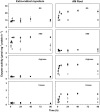Enzymatic evidence for the key role of arginine in nitrogen translocation by arbuscular mycorrhizal fungi
- PMID: 17142485
- PMCID: PMC1914155
- DOI: 10.1104/pp.106.090522
Enzymatic evidence for the key role of arginine in nitrogen translocation by arbuscular mycorrhizal fungi
Abstract
Key enzymes of the urea cycle and (15)N-labeling patterns of arginine (Arg) were measured to elucidate the involvement of Arg in nitrogen translocation by arbuscular mycorrhizal (AM) fungi. Mycorrhiza was established between transformed carrot (Daucus carota) roots and Glomus intraradices in two-compartment petri dishes and three ammonium levels were supplied to the compartment containing the extraradical mycelium (ERM), but no roots. Time courses of specific enzyme activity were obtained for glutamine synthetase, argininosuccinate synthetase, arginase, and urease in the ERM and AM roots. (15)NH(4)(+) was used to follow the dynamics of nitrogen incorporation into and turnover of Arg. Both the absence of external nitrogen and the presence of L-norvaline, an inhibitor of Arg synthesis, prevented the synthesis of Arg in the ERM and resulted in decreased activity of arginase and urease in the AM root. The catabolic activity of the urea cycle in the roots therefore depends on Arg translocation from the ERM. (15)N labeling of Arg in the ERM was very fast and analysis of its time course and isotopomer pattern allowed estimation of the translocation rate of Arg along the mycelium as 0.13 microg Arg mg(-1) fresh weight h(-1). The results highlight the synchronization of the spatially separated reactions involved in the anabolic and catabolic arms of the urea cycle. This synchronization is a prerequisite for Arg to be a key component in nitrogen translocation in the AM mycelium.
Figures








Similar articles
-
Arginine bi-directional translocation and breakdown into ornithine along the arbuscular mycorrhizal mycelium.Sci China C Life Sci. 2009 Apr;52(4):381-9. doi: 10.1007/s11427-009-0044-1. Epub 2009 Apr 21. Sci China C Life Sci. 2009. PMID: 19381464
-
The uptake, metabolism, transport and transfer of nitrogen in an arbuscular mycorrhizal symbiosis.New Phytol. 2005 Dec;168(3):687-96. doi: 10.1111/j.1469-8137.2005.01536.x. New Phytol. 2005. PMID: 16313650
-
Regulation of the nitrogen transfer pathway in the arbuscular mycorrhizal symbiosis: gene characterization and the coordination of expression with nitrogen flux.Plant Physiol. 2010 Jul;153(3):1175-87. doi: 10.1104/pp.110.156430. Epub 2010 May 6. Plant Physiol. 2010. PMID: 20448102 Free PMC article.
-
Forms of nitrogen uptake, translocation, and transfer via arbuscular mycorrhizal fungi: a review.Sci China Life Sci. 2012 Jun;55(6):474-82. doi: 10.1007/s11427-012-4330-y. Epub 2012 Jun 29. Sci China Life Sci. 2012. PMID: 22744177 Review.
-
[Metabolism and interaction of C and N in the arbuscular mycorrhizal symbiosis].Ying Yong Sheng Tai Xue Bao. 2014 Mar;25(3):903-10. Ying Yong Sheng Tai Xue Bao. 2014. PMID: 24984513 Review. Chinese.
Cited by
-
Evidence that arbuscular mycorrhizal and phosphate-solubilizing fungi alleviate NaCl stress in the halophyte Kosteletzkya virginica: nutrient uptake and ion distribution within root tissues.Mycorrhiza. 2014 Jul;24(5):383-95. doi: 10.1007/s00572-013-0546-3. Epub 2013 Dec 17. Mycorrhiza. 2014. PMID: 24343115
-
Beneficial soil-borne bacteria and fungi: a promising way to improve plant nitrogen acquisition.J Exp Bot. 2020 Jul 25;71(15):4469-4479. doi: 10.1093/jxb/eraa112. J Exp Bot. 2020. PMID: 32157312 Free PMC article. Review.
-
The potential role of Mucoromycotina 'fine root endophytes' in plant nitrogen nutrition.Physiol Plant. 2022 May;174(3):e13715. doi: 10.1111/ppl.13715. Physiol Plant. 2022. PMID: 35560043 Free PMC article.
-
Recently photoassimilated carbon and fungus-delivered nitrogen are spatially correlated in the ectomycorrhizal tissue of Fagus sylvatica.New Phytol. 2021 Dec;232(6):2457-2474. doi: 10.1111/nph.17591. Epub 2021 Aug 6. New Phytol. 2021. PMID: 34196001 Free PMC article.
-
Allocation of Carbon from an Arbuscular Mycorrhizal Fungus, Gigaspora margarita, to Its Gram-Negative and Positive Endobacteria Revealed by High-Resolution Secondary Ion Mass Spectrometry.Microorganisms. 2021 Dec 16;9(12):2597. doi: 10.3390/microorganisms9122597. Microorganisms. 2021. PMID: 34946198 Free PMC article.
References
-
- Ames RN, Reid CPP, Porter LK, Cambardella C (1983) Hyphal uptake and transport of nitrogen from two 15N-labelled sources by Glomus mossae, a vesicular arbuscular mycorrhizal fungus. New Phytol 95 381–396
-
- Azcón R, Gomez-Ortega M, Barea JM (1982) Comparative effects of foliar or soil applied nitrate on vesicular arbuscular mycorrhizal infection in maize. New Phytol 92 553–559
-
- Bago B, Pfeffer P, Shachar-Hill Y (2001) Could the urea cycle be translocating nitrogen in the arbuscular mycorrhizal symbiosis? New Phytol 149 4–8 - PubMed
-
- Bago B, Vierheilig H, Piche Y, Azcón Aguilar C (1996) Nitrate depletion and pH changes induced by the extra-radical mycelium of the arbuscular mycorrhizal fungus Glomus intraradices grown in monoxenic culture. New Phytol 133 273–280 - PubMed
Publication types
MeSH terms
Substances
LinkOut - more resources
Full Text Sources

